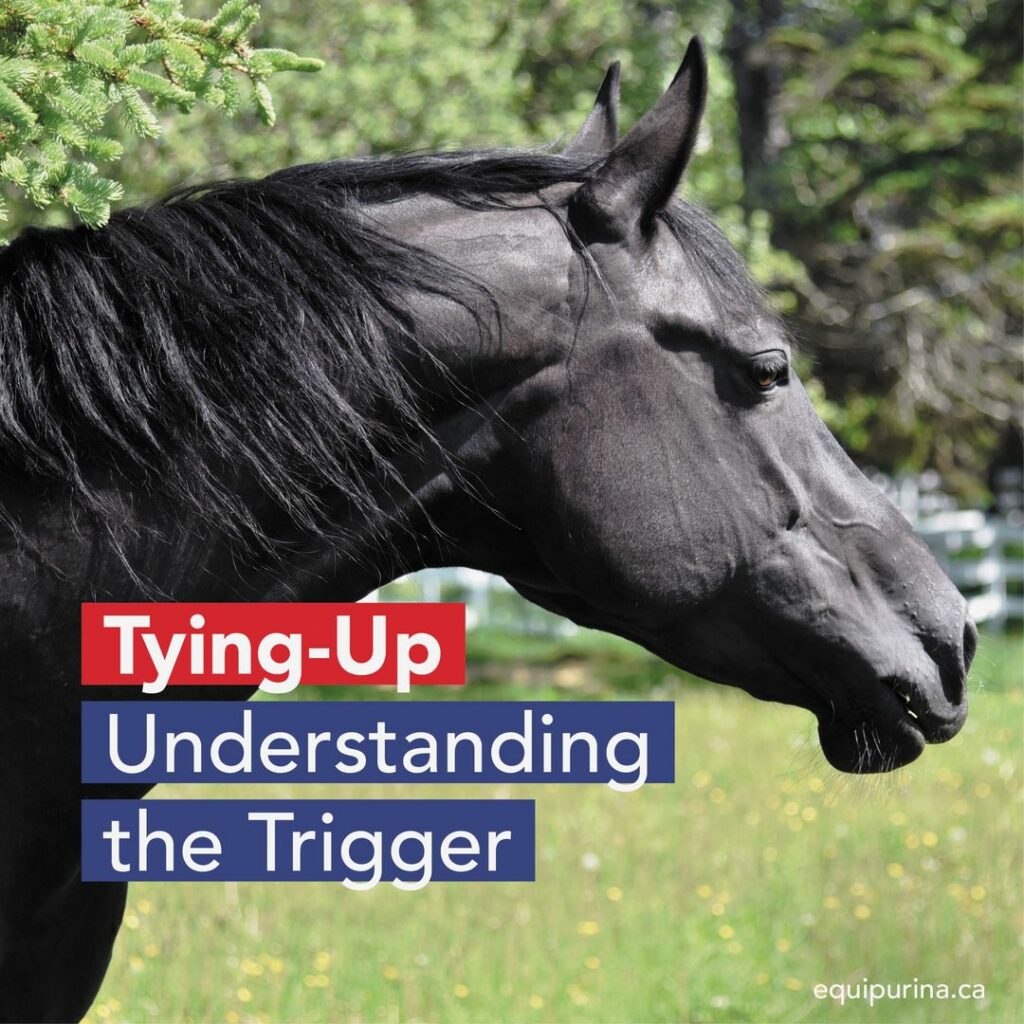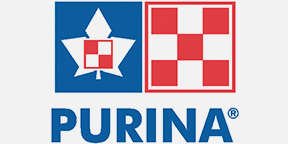
Exertional Rhabdomyolysis (ER), commonly referred to as tying-up, has perplexed researchers and horsemen for decades. Much of the confusion originates from the tendency to group all horses that show muscle cramping and soreness associated with exercise into one disease. In fact, tying-up should be viewed as a broad term or syndrome used to describe a variety of muscle disorders, much like colic is a syndrome for a variety of digestive upsets. By looking at tying-up as a symptom rather than a single disease, researchers at the University of Minnesota (Valberg2001) started to better understand why horses tie up.
THREE SEPARATE FORMS OF ER
This new direction, together with advancement in research technology, has led researchers to categorize three separate forms of ER. These include:
- Sporadic Exertional Rhabdomyolysis;
- and two types of Chronic Exertional Rhabdomyolysis:
o Equine Polysaccharide Storage Myopathy (EPSM) and Recurrent;
o Exertional Rhabdomyolysis (RER)
The major difference between sporadic ER and the two forms of chronic ER, in addition to what the names imply, is that sporadic ER is associated with intrinsically normal muscle function, but the horse is over-stressed and exercised to exceed its current fitness level. Sporadic ER may well be what we see in endurance horses as a component of the “exhausted horse syndrome”. With this form of ER, electrolyte imbalances and vitamin E and/or selenium deficiency may play a greater role.
In contrast, with chronic ER the horse is actually exercising within his current fitness level, yet the horse ties-up. It appears that something in the horse’s environment seems to trigger muscles to inherently malfunction. Chronic ER is the most frustrating and debilitating form of tying-up and will be the main focus of this article.
CREATINE KINASE (CK)
One distinctive characteristic among all forms of tying-up is an elevated plasma creatine kinase (CK). Creatine kinase is an enzyme that is in particularly high concentrations within muscle cells. It plays an important role in energy production for muscle cells. Elevated plasma CK levels represent the leakage of CK from damaged muscle cells into the bloodstream. Generally, it takes 4 to 6 hours after a bout of tying-up for plasma CK levels to peak. However, these plasma CK levels will also drop as quickly as they escalate. Therefore, when blood samples are collected at appropriate times after a bout of tying-up, CK is a useful marker for determining the magnitude and duration of muscle damage.
CK AND CHRONIC ER
Though not proven in all breeds, there are implications that chronic ER is a genetic disease. Genetic research in Thoroughbreds has implied that susceptibility to RER is inherited as a dominant trait. Consequently, there is no cure for chronic ER, but there are extensive management practices and treatments capable of controlling or preventing episodes.
Horses that chronically tie-up, irrespective of the type, need to be exercised on a regular basis, preferably daily. Indications are showing higher CK levels in Thoroughbreds post-exercise, following a day of rest, compared to horses postexercise, but not preceded by a rest day. In addition, horses that suffer from either form of chronic ER must be fed according to workload, and particular attention should be made to rest days. In effect, grain-based feeds, which provide the greatest amount of calories, should be decreased and the proportion of forage increased, especially with horses with ESPM as they accumulate glycogen in their muscle cells.
EPSM VS RER
An understanding of the aetiology of EPSM (Equine Polysaccharide Storage Myopathy) and RER (Exertional Rhabdomyolysis) is necessary to properly manage horses with these specific disorders. Some of the clinical differences between EPSM and RER are listed below:
| EPSM | RER |
|---|---|
| – 1.5 to 4 times normal levels of muscle glycogen levels; – Presence of an abnormal polysaccharide in muscle cells; – Enhanced insulin sensitivity; – Occurs primarily in unfit horses; – Occurs in calm and sedated horses; – Occurs primarily in Draft horses, – Warmbloods and Quarter horses; – No occurrence of lactic acid | – Normal muscle glycogen levels; – No abnormal polysaccharide; – Normal insulin sensitivity; – Occurs primarily in fit horses; – Occurs more so in nervous and excitable horses, i.e. Fillies. |
EPSM
Polysaccharide storage myopathy is very typical of Monday Morning disease, as the risk of an episode is considerably greater in horses exercising after a rest day. Therefore, they must be able to move every day, so that they will be able to use glycogen instead of accumulating it. Muscle glycogen levels in EPSM horses are 1.5 to 4 times higher than normal horses, classifying this form of chronic ER as a glycogen storage disorder. In fact, these horses have normal glycogen utilisation, but have higher rates of glycogen synthesis through an increased uptake of blood glucose. This increased glucose uptake by the muscle. In addition, a distinctive characteristic of EPSM is the presence of abnormal polysaccharide in particular muscle fibres.
Fundamental management of EPSM requires the decrease or preferable complete elimination of starch from the diet. Ideally, a strictly fat and fibre diet should be provided to maintain body condition while ensuring vitamins and minerals are meeting intake requirements. Fortunately, horses with EPSM tend to be easy keepers and therefore can easily maintain proper body condition on such a diet. Following an EPSM episode, exercise must be reintroduced very gradually. Even if plasma CK levels are normal, two weeks of turnout are necessary. Dr Valberg suggests starting with 5 minutes/day of longeing at a walk and trot, increasing by 2 min/day, and not riding until three weeks of longeing.
Horses with EPSM need to be kept on a continual work program, and greatly improve as their fitness increases.
RER
In contrast to horses with EPSM, horses with RER are more susceptible to tying-up as their fitness increases and have normal muscle glycogen levels. Horses with RER show abnormal calcium regulation within their muscle cells. Simply put, the sarcoplasmic reticulum (SR), a calcium containing vacuole in muscle cells, is defective or hypersensitive and consequently releases more calcium than it is able to reabsorb. The presence of calcium within muscle fibres enables muscle contraction, however, the calcium must be returned to the SR for the muscle fibre to relax. When the re-uptake of calcium is inadequate, some muscle fibres will not relax and eventually tear. This calcium regulation defect
occurs strictly within muscle cells and at extremely low calcium levels, and is no way influenced by dietary calcium levels.
The onset of RER requires two factors: a susceptible candidate and a triggering factor causing the calcium channel to malfunction. RER can be triggered by a multitude of factors; therefore, the treatment of this condition should be a multiapproach involving management, exercise, nutrition and medication when needed. In practice, it’s best to examine the horse suffering with RER and try to determine the triggering factors. What works for one horse may not work for all, and the more multifactorial your approach, the greater the chances of success.
STRESS-FREE ENVIRONMENT
A stress-free environment is of the utmost importance when managing horses with RER, emphasizing on consistency and avoidance of any management changes that will increase excitability. Consider the stall location, increase turnout time, and try to expose horses to new events gradually and ahead of time. The use of tranquilizers when introducing horses to new circumstances or particularly stressful situations can be advantageous. Diets rich in rapidly digestible starch seem to induce greater excitability in horses with RER compared to normal horses. Therefore, it’s preferable not to feed straight oats or extruded feeds to horses with RER. These horses can tolerate some starch, but not a lot at the same time. Consequently, they should be given as many meals a day as possible (at least three a day) and each feeding should be of equal proportions. It has been suggested that it is advantageous to feed a small meal before exercise and a larger meal immediately after. Preferably, horses suffering from RER should be fed a high-fat, high-fibre diet. No less than 6% fat and high content of super fibres such as soy hulls and beet pulp.
| Tying-up induces major oxidative damage to muscles, which is why antioxidants such as Vitamin E and selenium are recommended. Vitamin E and Selenium (especially organic selenium) can help reduce the severity of an RER episode, rather than its occurrence. I recommend a minimum of 2 to 3 mg of selenium and 2000 to 5000 IU of Vitamin E per day for a 450 kg (1,000lb) horse. A supplement with a fortified complete vitamin-B complex, in addition to having possible calming effect (and thereby helping to prevent tying-up), could also help the horse cope better with the stress of tying-up. Electrolyte imbalances can play a prominent role in the onset of RER. As well as playing an important role in proper muscle function, dehydration may cause excitability and possibly lead to tying-up. Low levels of potassium in red blood cells levels have also been detected in horses that tie-up, but this appears to be a symptom rather than a causal effect. Depending on the feeding program, I recommend that horses with RER be supplemented with 30 to 90 grams/day of a 3:1 mixture of sodium chloride and potassium chloride. |
In conclusion, strained muscles can also be mistakenly diagnosed as tying-up, adding to the confusion surrounding ER. The greatest challenge when handling horses that demonstrate symptoms of tying-up is to determine the type of muscle disorder. Is it a simple muscle strain, sporadic ER, EPSM or RER? With EPSM a muscle biopsy can be sent to the University of Minnesota for positive identification of the abnormal polysaccharide. Proper identification of other types of muscle disorders is not as precise. Once the cause is established, the objective is to implement as many of the appropriate preventative measures necessary to reduce and hopefully eliminate the clinical expression of tying-up.
Due to the challenge of tying-up, contacting your local Purina Equine Consultant will help you choose the right product for the forage in your area. Equilibrium Trimax and Equilibrium XCEL HD are excellent considerations for moderate and low-NSC products respectively, for use by the equine athlete. These are highcalorie, high-fat, high-Omega 3 products suitable for these circumstances. For acute situations, when the horse is rested, and calories need to be reduced, Super Fibra Integri T with a NSC of 10% is ideal.
Balancing your vitamins, minerals and amino acids with a low NSC Ration Balancer like Optimal or Equilizer is also recommended. Additionally, horses experiencing high levels of stress due to pain and discomfort associated with this issue, and perhaps taking medications to address it, can benefit from excellent support using a gastric supplement such as Digestive Balance, which is also low NSC and contains post-biotics. Additional pre/probiotics also have benefits. Horse Shield can provide these as part of your program.
For more information, visit equipurina.ca.
Author:
– Katerine Pard, Agr., Senior Equine Nutrition Consultant – katerine_pard@cargill.com
Contributors:
– Cindy Cook, Senior Equine Nutrition Consultant – cindy_cook@cargill.com
– Keri Weir, Senior Equine Nutrition Consultant – keri_weir@cargill.com
Reference:
Valberg.,S J., Muscling in on the Cause of Tying-Up, AAEP Proceedings 2012, v. 582012, p.85 – 123.
Valberg.,S.,Tying up Syndrome, mastersonmethod.com/fieldwork/wpcontent/uploads/Tying_UP1.pdf, 2001., University of Minnesota.










